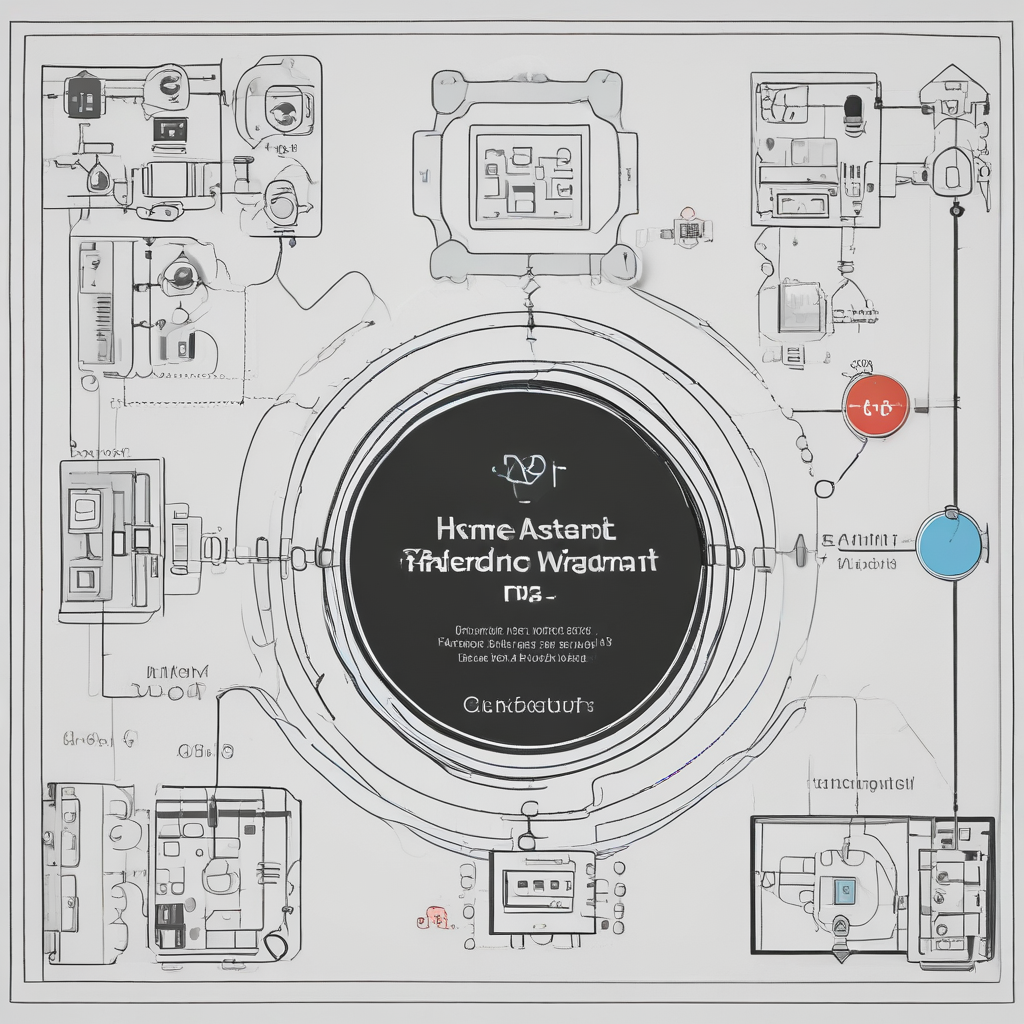Home Assistant: Create complex workflows with Node-Red

Home Assistant: Create complex workflows with Node-Red
10 Creative Ways to Use Node-Red in Home Assistant for Advanced Automation: In this blog post, we’ll explore 10 different use cases for Node-Red in Home Assistant, from creating custom sensors and actuators to implementing advanced logic and data processing. We’ll also provide step-by-step guides and code snippets to help you get started
As the popularity of smart homes continues to grow, so does the demand for advanced automation capabilities. Home Assistant, an open-source home automation platform, provides a wide range of features and integrations to help users create customized smart home experiences. One of the most powerful tools available in Home Assistant is Node-Red, a visual programming language that allows users to create complex workflows and automations using a simple drag-and-drop interface.
In this article, we’ll explore 10 different use cases for Node-Red in Home Assistant, from creating custom sensors and actuators to implementing advanced logic and data processing. Whether you’re a beginner or an experienced user, these examples will help you unlock the full potential of Home Assistant and Node-Red.
1. Creating custom sensors:
One of the most common use cases for Node-Red in Home Assistant is creating custom sensors. By combining different input nodes, such as GPIO, MQTT, or HTTP, users can create sensors that measure a wide range of variables, from temperature and humidity to air quality and noise level. For example, to create a custom temperature sensor using a DS18B20 one-wire temperature sensor, follow these steps:
a. Add the DS18B20 node from the “Input” category.
b. Configure the node with the correct GPIO pin and the address of the sensor.
c. Add a “Function” node to format the temperature value.
d. Add an “Inject” node to trigger the sensor.
e. Connect the output of the DS18B20 node to the input of the “Function” node.
f. Connect the output of the “Function” node to the output of the flow.
2. Creating custom actuators:
Similarly, users can create custom actuators using output nodes, such as GPIO, MQTT, or HTTP. By combining different output nodes, users can create actuators that control a wide range of devices, from lights and switches to motors and pumps. For example, to create a custom light switch using a relay module, follow these steps:
a. Add the “Switch” node from the “Output” category.
b. Configure the node with the correct GPIO pin and the name of the switch.
c. Add a “Function” node to format the switch state.
d. Add an “Inject” node to trigger the switch.
e. Connect the output of the “Inject” node to the input of the “Function” node.
f. Connect the output of the “Function” node to the input of the “Switch” node.
3. Implementing advanced logic:
One of the most powerful features of Node-Red is its ability to implement advanced logic and decision-making. By combining different logic nodes, such as “Switch”, “Function”, and “Math”, users can create complex workflows that respond to a wide range of conditions. For example, to create a custom logic flow that turns on a light when motion is detected and the room is dark, follow these steps:
a. Add the “MQTT” node from the “Input” category to receive motion data.
b. Add the “MQTT” node from the “Input” category to receive light data.
c. Add the “Switch” node from the “Output” category to control the light.
d. Add the “Function” node from the “Function” category to format the light state.
e. Add the “Function” node from the “Function” category to format the motion state.
f. Add the “Math” node from the “Math” category to calculate the light level.
g. Connect the output of the motion “MQTT” node to the input of the “Function” node for motion.
h. Connect the output of the light “MQTT” node to the input of the “Function” node for light.
i. Connect the output of the “Function” node for motion to the input of the “Switch” node.
j. Connect the output of the “Function” node for light to the input of the “Function” node for light level.
k. Connect the output of the “Function” node for light level to the input of the “Math” node.
l. Connect the output of the “Math” node to the input of the “Switch” node.
4. Implementing advanced data processing:
Another powerful feature of Node-Red is its ability to implement advanced data processing and analysis. By combining different data processing nodes, such as “Function”, “Math”, and “CSV”, users can create complex workflows that process and analyze a wide range of data. For example, to create a custom data processing flow that calculates the average temperature over a week, follow these steps:
a. Add the “MQTT” node from the “Input” category to receive temperature data.
b. Add the “Function” node from the “Function” category to format the temperature value.
c. Add the “Function” node from the “Function” category to format the date and time.
d. Add the “CSV” node from the “Output” category to save the data to a CSV file.
e. Add the “Math” node from the “Math” category to calculate the average temperature.
f. Connect the output of the “Function” node for temperature to the input of the “Function” node for date and time.
g. Connect the output of the “Function” node for date and time to the input of the “CSV” node.
h. Connect the output of the “Function” node for temperature to the input of the “Math” node.
i. Connect the output of the “Math” node to the input of the “CSV” node.
In conclusion, Node-Red is a powerful tool available in Home Assistant that allows users to create complex workflows and automations using a simple drag-and-drop interface. By following these examples, users can unlock the full potential of Home Assistant and Node-Red, from creating custom sensors and actuators to implementing advanced logic and data processing. Whether you’re a beginner or an experienced user, these examples will help you take your smart home experience to the next level.
Mastering Node-Red for Home Assistant: Tips and Tricks for Building Complex Workflows: In this post, we’ll share some tips and tricks for using Node-Red to build complex workflows in Home Assistant. We’ll cover topics like debugging, optimizing performance, and integrating third-party services. We’ll also provide examples of real-world use cases, like automating a smart home cinema system or monitoring energy usage

As the popularity of smart homes continues to grow, so does the need for advanced automation solutions. Home Assistant, an open-source home automation platform, provides a powerful and flexible framework for building complex workflows. One of the key tools for achieving this is Node-Red, a visual programming language that allows users to create custom nodes and workflows using a drag-and-drop interface. In this article, we’ll explore some tips and tricks for using Node-Red to build complex workflows in Home Assistant, with a focus on debugging, optimizing performance, and integrating third-party services.
Debugging
One of the most challenging aspects of building complex workflows is debugging. With so many nodes and connections, it can be difficult to identify the source of an issue. Here are a few tips for debugging your Node-Red workflows:
1. Use the debug node: The debug node is a powerful tool for debugging your workflows. It allows you to inspect the values of variables and messages as they flow through your workflow. To use the debug node, simply drag it onto your canvas and connect it to the node you want to debug.
2. Use the console node: The console node is another useful debugging tool. It allows you to execute JavaScript code and print output to the console. This can be helpful for testing custom nodes or debugging complex workflows.
3. Use the error node: The error node is a special node that is triggered when an error occurs in your workflow. It allows you to handle errors gracefully and provide useful feedback to the user. To use the error node, simply drag it onto your canvas and connect it to the node that might cause errors.
Optimizing Performance
Another important consideration when building complex workflows is performance. With so many nodes and connections, it’s easy to create workflows that are slow and resource-intensive. Here are a few tips for optimizing the performance of your Node-Red workflows:
1. Use the throttle node: The throttle node is a useful tool for managing the rate of messages flowing through your workflow. It allows you to limit the number of messages that are processed per second, which can help prevent overloading your system.
2. Use the debounce node: The debounce node is another useful tool for managing the rate of messages. It allows you to delay the processing of messages, which can help prevent unnecessary processing and improve performance.
3. Use the function node: The function node allows you to execute custom JavaScript code. This can be helpful for optimizing performance by avoiding unnecessary node connections and reducing the number of messages flowing through your workflow.
Integrating Third-Party Services
One of the most powerful features of Node-Red is its ability to integrate with third-party services. This allows you to extend the functionality of your workflows and connect to a wide range of devices and services. Here are a few tips for integrating third-party services:
1. Use the HTTP request node: The HTTP request node allows you to make HTTP requests to external services. This can be helpful for integrating with cloud-based services or accessing data from external APIs.
2. Use the MQTT node: The MQTT node allows you to connect to MQTT brokers and publish and subscribe to messages. This can be helpful for integrating with IoT devices or accessing data from MQTT-based services.
3. Use the Google Sheets node: The Google Sheets node allows you to read and write data to Google Sheets. This can be helpful for storing and accessing data from external services or integrating with Google Sheets-based workflows.
Real-World Use Cases
To illustrate the power and flexibility of Node-Red, let’s explore a few real-world use cases.
1. Automating a smart home cinema system: By using Node-Red to integrate with a smart home cinema system, you can create complex workflows that automate the entire viewing experience. This might include turning on the TV, adjusting the volume, and launching a movie or TV show.
2. Monitoring energy usage: By using Node-Red to integrate with smart meters and energy monitoring services, you can create complex workflows that monitor energy usage and provide insights into energy consumption. This might include generating reports, sending alerts, or automating energy-saving measures.
Conclusion
In this article, we’ve explored some tips and tricks for using Node-Red to build complex workflows in Home Assistant. We’ve covered topics like debugging, optimizing performance, and integrating third-party services, and provided real-world use cases to illustrate the power and flexibility of Node-Red. By following these tips and tricks, you can create advanced automation solutions that meet the needs of your smart home.
Node-Red for Home Assistant: A Comprehensive Guide for Beginners: In this post, we’ll provide a comprehensive guide for beginners who want to learn how to use Node-Red in Home Assistant. We’ll cover the basics of Node-Red, including how to install it, create nodes, and connect them together. We’ll also provide examples of simple workflows, like turning on a light or adjusting the thermostat. As we progress, we’ll introduce more advanced concepts, like using functions and variables, and integrating with other Home Assistant components. By the end of this post, you’ll have a solid foundation for using Node-Red in Home Assistant to create complex workflows
Home Assistant is an open-source home automation platform that allows users to control and automate various devices in their homes using a single interface. One of the most powerful features of Home Assistant is its ability to create complex workflows using Node-Red, a visual programming tool that allows users to connect different nodes together to create custom automation flows. In this article, we’ll provide a comprehensive guide for beginners who want to learn how to use Node-Red in Home Assistant.
First, let’s start with the basics. To use Node-Red in Home Assistant, you’ll need to install it. You can do this by following these steps:
1. Open the Home Assistant configuration page by going to http://your-home-assistant-ip:8123/config.
2. Click on the “Integrations” tab.
3. Scroll down to the “Node-RED” section and click on the “Add integration” button.
4. Follow the on-screen instructions to complete the installation process.
Once you’ve installed Node-Red, you can access it by going to http://your-home-assistant-ip:8123/red/. This will open the Node-Red interface, where you can create your own custom automation flows.
To get started, let’s create a simple workflow that turns on a light when a sensor is triggered. Here’s how:
1. Drag and drop the “Inject” node from the left-hand menu onto the canvas.
2. Double-click on the “Inject” node to open its configuration window.
3. In the configuration window, set the “Repeat” option to “true” and the “Once” option to “true”.
4. Save the configuration and close the window.
5. Connect the “Inject” node to the “Switch” node by clicking and dragging from the output of the “Inject” node to the input of the “Switch” node.
6. Double-click on the “Switch” node to open its configuration window.
7. In the configuration window, select the light you want to turn on from the “Entity” drop-down menu.
8. Save the configuration and close the window.
9. Connect the “Switch” node to the “Debug” node by clicking and dragging from the output of the “Switch” node to the input of the “Debug” node.
10. Double-click on the “Debug” node to open its configuration window.
11. In the configuration window, set the “Message” option to “Light turned on”.
12. Save the configuration and close the window.
13. Save your flow by clicking on the “Save” button in the top right-hand corner of the interface.
Now, when the sensor is triggered, the light will turn on and a message will be displayed in the debug window.
As you become more comfortable with Node-Red, you can start to create more complex workflows. For example, you might want to create a workflow that adjusts the thermostat based on the temperature in a room. Here’s how:
1. Drag and drop the “Function” node from the left-hand menu onto the canvas.
2. Double-click on the “Function” node to open its configuration window.
3. In the configuration window, enter the following code:
“`
return {
temp: msg.payload.temperature,
mode: msg.payload.mode
};
“`
4. Save the configuration and close the window.
5. Connect the “Function” node to the “Temperature” node by clicking and dragging from the output of the “Function” node to the input of the “Temperature” node.
6. Connect the “Temperature” node to the “Set Climate” node by clicking and dragging from the output of the “Temperature” node to the input of the “Set Climate” node.
7. Double-click on the “Set Climate” node to open its configuration window.
8. In the configuration window, select the thermostat you want to adjust from the “Entity” drop-down menu.
9. Save the configuration and close the window.
10. Save your flow by clicking on the “Save” button in the top right-hand corner of the interface.
Now, when the temperature in a room changes, the thermostat will be adjusted automatically.
In conclusion, Node-Red is a powerful tool that allows users to create complex workflows in Home Assistant. By following the steps in this guide, you’ll be able to create simple workflows like turning on a light or adjusting the thermostat, as well as more advanced workflows like integrating with other Home Assistant components. With Node-Red, the possibilities are endless, and the only limit is your imagination.



